Up Next
One-to-Watch Chris Oh Replicates Classic Renaissance Imagery on Geodes, Shells, and Other Natural Forms to Uncanny Effect
The artist is currently preparing for a solo exhibition at Capsule Gallery in Shanghai this fall.
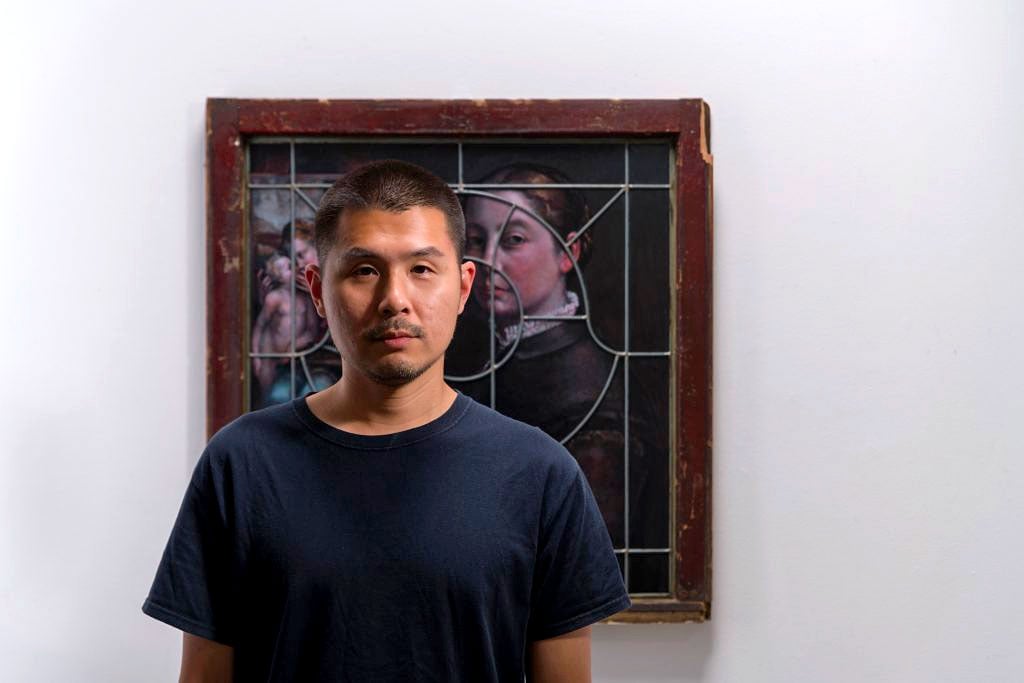
The artist is currently preparing for a solo exhibition at Capsule Gallery in Shanghai this fall.

Katie White

As a small child, the artist Chris Oh (b. 1982) would spend hours copying drawings from encyclopedias at his parents’ home in Portland, Oregon. “I had these 1990s World Book encyclopedias that I would really pore over, copying anatomical charts and space,” he told me over the phone, “I’d do it again and again. I thought it was really fun.”
The memory is telling; the Queens, New York-based artist is known for his astonishingly precise replications of historical artworks—mainly from the Renaissance—which he paints on unexpected objects.
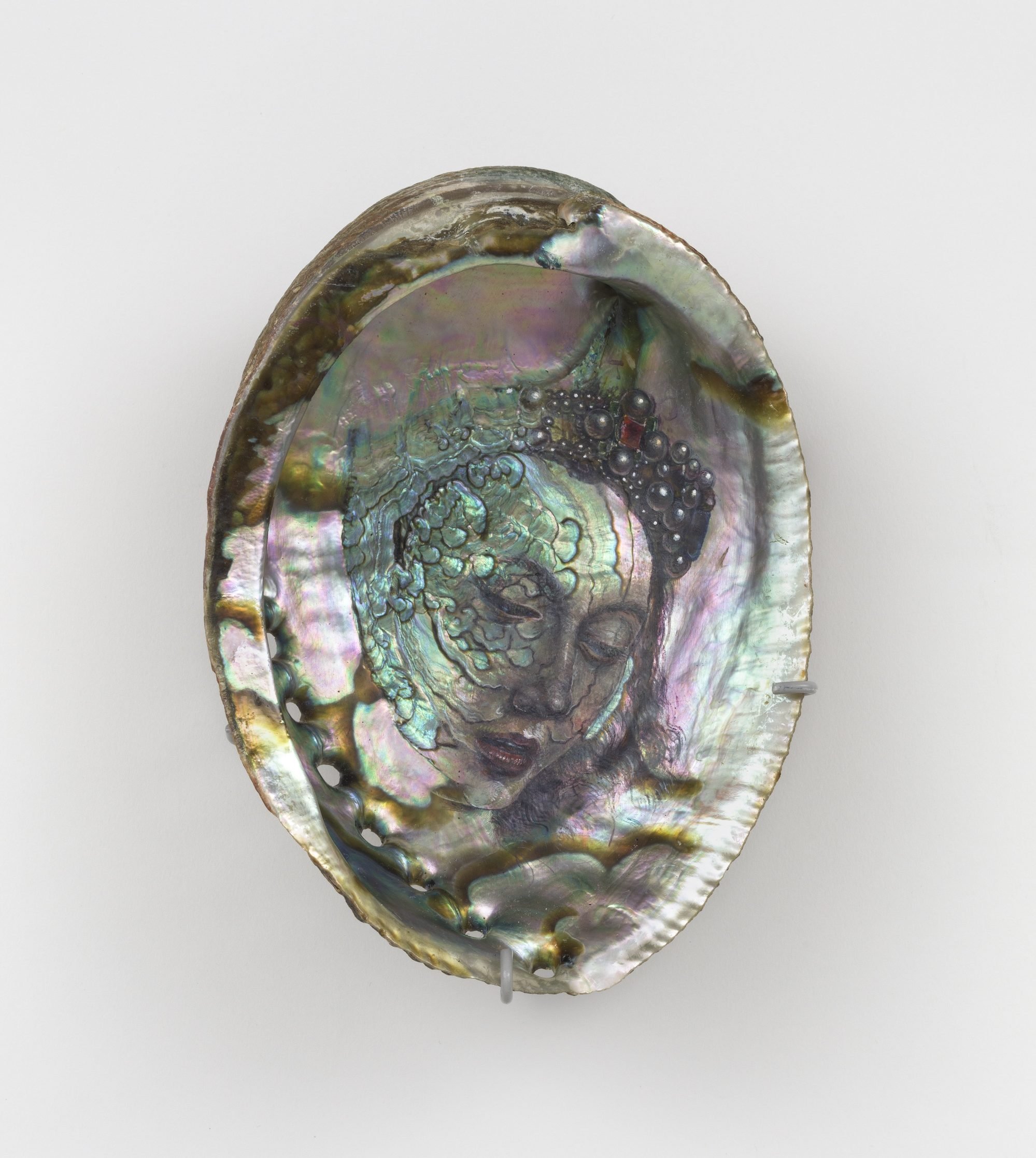
Chris Oh, Tides (2023). Courtesy of the artist and Fortnight Institute, New York.
Weeping Madonnas materialize, seemingly miraculously, on glittering geodes and nacreous shells. Da Vinci drawings stretch across bed sheets and pillowcases. Landscapes hover at the fore-edges of a stack of well-worn books. His unlikely pairings are both recognizable and disorienting. In one recent work, Chasm, the face of the Virgin Mary seems to be emerging from within a rock form itself, rather than painted onto it.
For Oh, channeling these centuries-old paintings onto new forms is a lesson in what subject matter transcends time and place. “The emotional interaction with my work is something I think a lot about. I observe what I’m drawn to in say a Renaissance painting that still speaks to me,” he explained. “Images of grief and pain last a long time, but so does the beauty of love. Beauty endures.”
Over the past few years, Oh’s captivating body of work has earned the attention of a sweep of galleries. Currently, his work is included in “Snakes in the Grass,” a group show at Newchild Gallery in Antwerp. Works are also slated for shows, “Portal” at Arusha Gallery in London and “Pictures Girls Make: Portraitures,” curated by Alison Gingeras at Blum & Poe, both in September. This November, he will open a solo exhibition with Capsule Shanghai, his first in China, followed by his third solo show with New York’s Fortnight Institute in early 2024.
While there’s a lot ahead, he resists getting carried away. “Life is so unexpected,” he said with a laugh. “I’m lucky enough to do what I love, but I try to keep balance. As I get older, I want to stay healthy and to have a nice day most of the time. That’s important, too.”
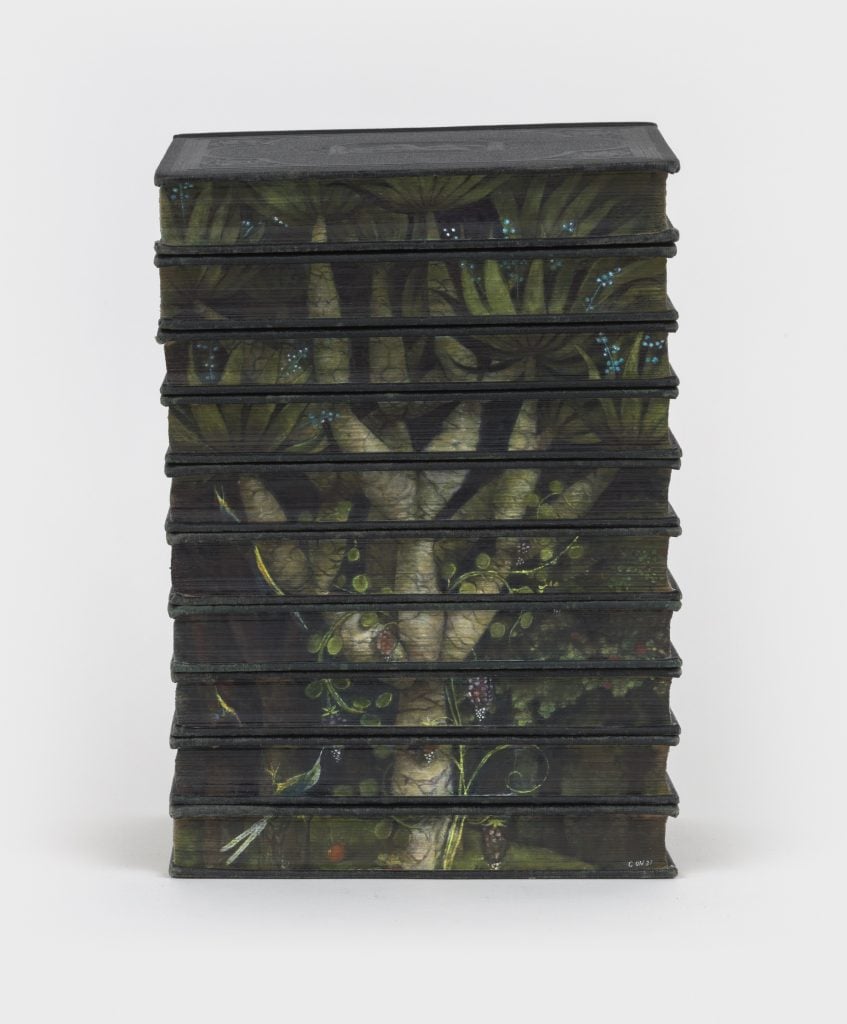
Chris Oh, Codex (2021). Courtesy of the artist and Fortnight Institute, New York.
Oh, who graduated from New York’s School of Visual Arts in 2004, has learned about the art of patience. Gifted with a fluent technical ability, he nevertheless struggled to identify his voice. “After school, I stayed in New York doing a lot of different odd jobs as many artists do. I was not sure what to paint for a long time,” he said. “Sometimes limitations can guide you, but I’ve always been good at copying things, which meant in some ways, I had a lot of different choices about what direction to go to in. And I was just stalling.”
Eventually, he began assembling bits of ephemera, sci-fi imagery, and book covers into his compositions in a way that felt meaningful. Still, he found the rectangle of the canvas oddly confining. One day, he decided to copy a Da Vinci print he had in his studio onto an Ikea dish towel. “I needed to work up my courage,” he said. “The towel was still a rectangle, but it didn’t have the structure. It opened up this whole new realm of possibility.”
After that, the artist started scouring his apartment and studio for objects to paint on, noting a “hoarding” tendency. “The objects became almost a portrait of my life, and I would be reminded where I was when I found some piece of rubble,” he recalled.
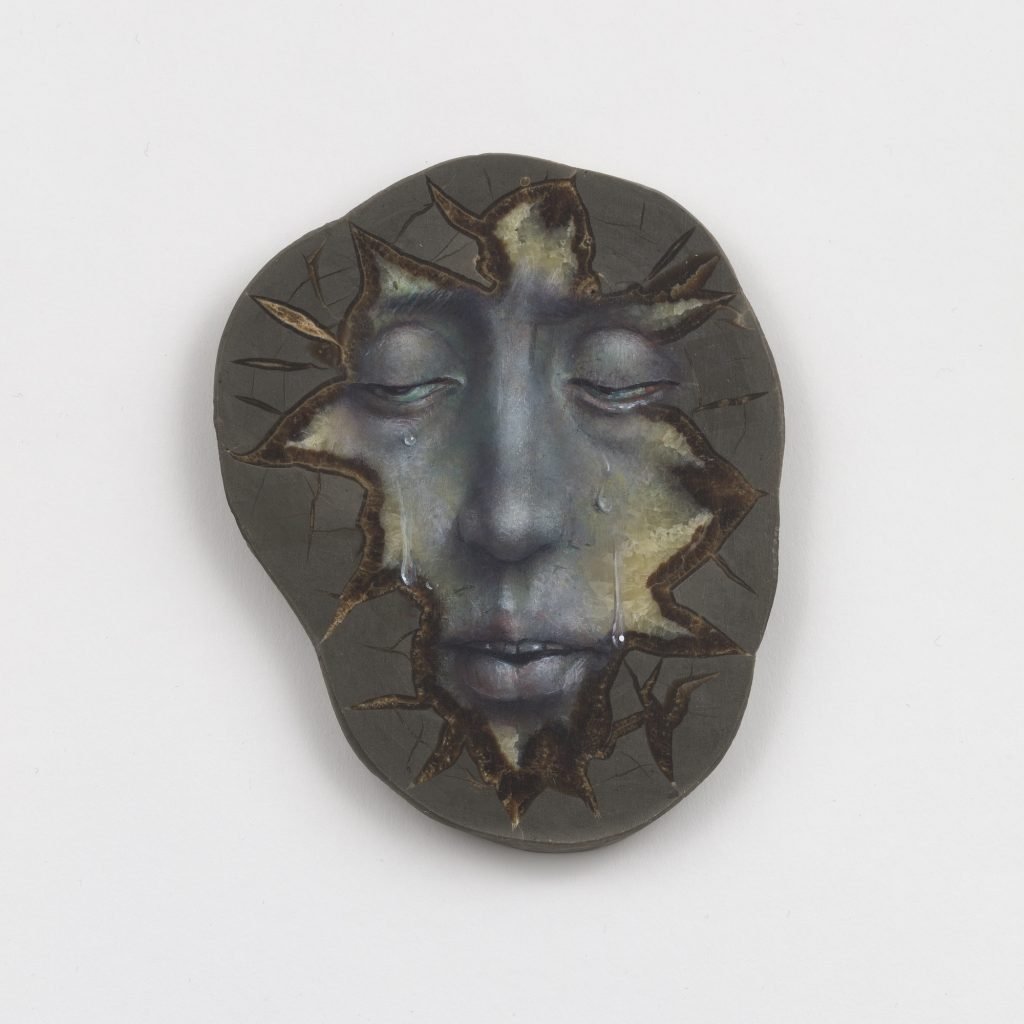
Chris Oh, Chasm (2022). Courtesy of the artist and Fortnight Institute, New York.
Oh’s first solo show “Plays” at New York’s Fortnight Institute in 2016 brought together many of these works, which showcased both the breadth of his materials as well as his art historical lexicon—with references to Leonardo Da Vinci, Jean-Auguste-Dominique Ingres, Caravaggio, Gustave Courbet, and Ancient Egyptian mummy portraits, along with many others.
“I learned a lot from that show,” said Oh. “I realized a lot of what I was drawn to were details from the Flemish primitives of the Northern Renaissance. I hadn’t really been too familiar with a lot of those artists beyond Van Eyck and Bruegel, but I found I wanted to be exposed to even more of that rich history.”
In particular, he was drawn to the paintings’ juxtaposition of intensive details with slightly wonky perspectives. “The camera obscura wasn’t as widely used as in the 16th century, so the images are very sophisticated and elegant in their rendering, but there’s this feeling of the uncanny. It’s very familiar but something’s a little off,” he explained. “That’s what I go for in my work as well. That revelation of transformation is what I get excited about.” In some ways, Oh’s materials play with perspective drawn from the painterly tricks of the Old Masters themselves. One thinks of the anamorphic skull on the floor of Hans Holbein’s Two Ambassadors or the revealing mirror on the back wall of Jan Van Eyck’s Arnolfini Portrait.
While questions of appropriation and authorship today might root back to Warhol or Sherry Levine, Oh is after something else entirely, finding a connection to historical traditions of knowledge transmission.
“These traditions go beyond European painting. In many different cultures, people have copied themes and designs as a way of passing knowledge,” he said. “Artists copied from one another as a way of learning and sharing. People weren’t sending photographs and text messages.” These interests sometimes send the artist on deep dives into bibliographies or Renaissance copies. “Bruegel gave his cartoons and designs to his son, who had this whole career based on his father’s body of work,” he explained enthusiastically.
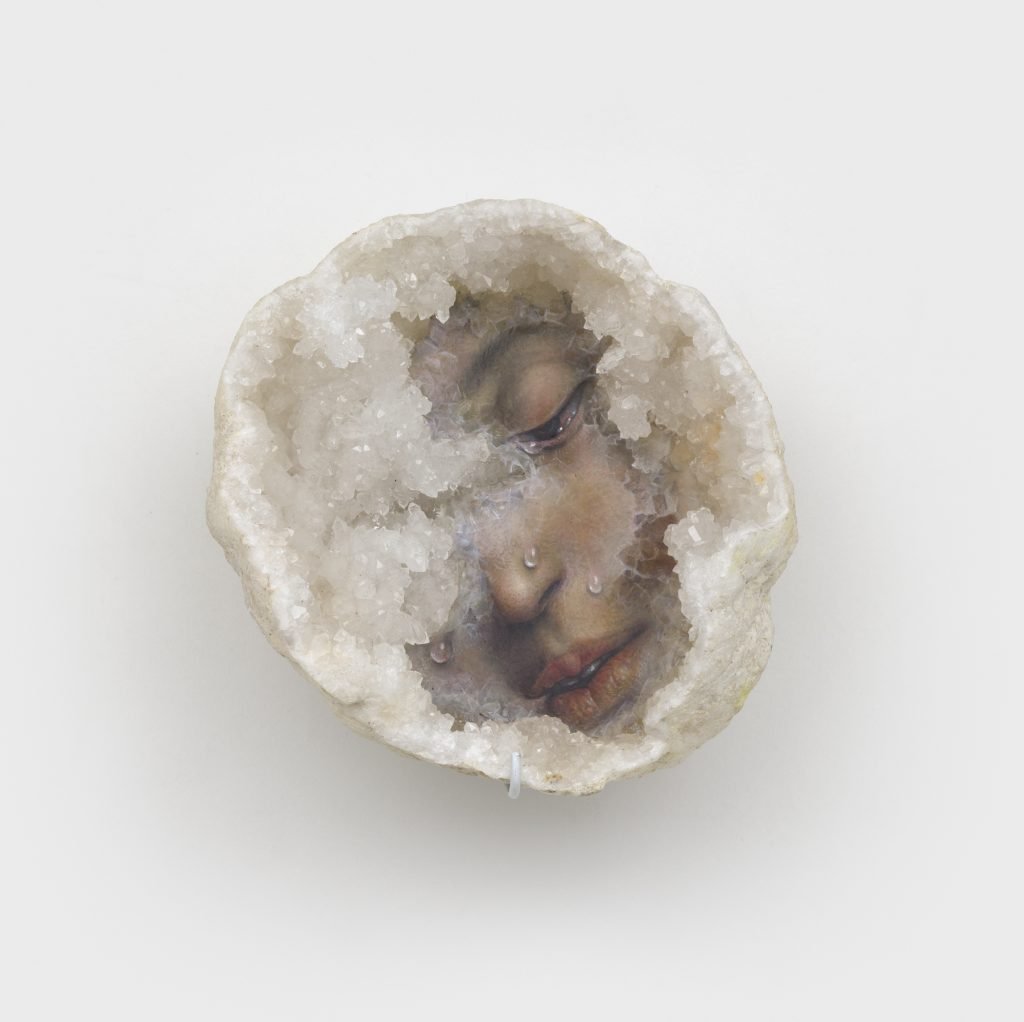
Chris Oh, Cove (2022). Courtesy of the artist and Fortnight Institute, New York.
Copies were a way that knowledge survived disaster. “So much of human culture we only know about through copies, because originals were destroyed. Many of the paintings I’m taking from are made by unknown artists,” he said. “The Renaissance itself was a celebration of a past culture that could have been lost to us otherwise.”
These works, which so often join religious imagery and solid materials of rock and minerals, go beyond this, too, asking existential questions about humanity and our relationship to the world around us. “A shell, or a piece of wood, or a crystal, or architectural salvage—these materials consider our relationship with nature and how we connect with it,” he said.
“Over the centuries, what remains? Objects made of stone, buried under the earth, or in a church, temple, or burial ground. These are objects of devotion where humans have contemplated the nature of the soul and the mysteries of human existence, the very basic question: Why are we here?” said Oh. “I’m trying to make relics, in a way, objects that exist outside of the confines of a certain time period, that have survived on and in the earth.”